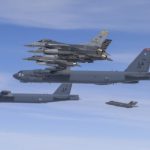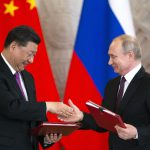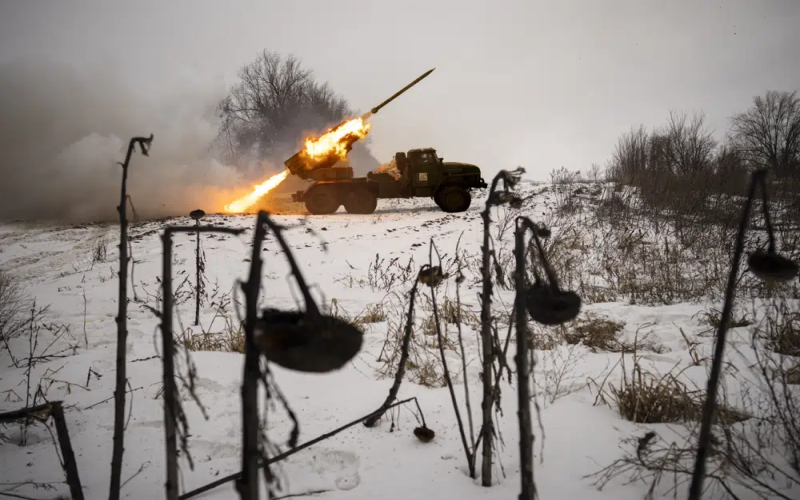
KUPIANSK, Ukraine (AP) — A tank carrying Ukrainian infantry speeds toward a target position marked with a metal sheet. The soldiers climb down, hurl grenades and unleash a crackle of machine-gun fire. Then they repeat the moves, getting faster with every iteration.
It’s only a drill. But with the sounds of the real war rumbling just seven kilometers (four miles) away, this daily training underscores the high stakes on Ukraine’s northeastern front, where military officials say a much-anticipated Russian offensive has already started, with fighting that could determine the next phase of the conflict.
Time is of the essence here, so speed and cohesion is the goal of the exercises that combine reserve tank and the infantry assault units.
“Synchronization will be important to halt Russian offensives toward Ukrainian defensive lines,” said Col. Petro Skyba, a battalion commander of the 3rd Separate Tank Iron Brigade.
Grueling artillery battles have stepped up in recent weeks in the vicinity of Kupiansk, a strategic town on the eastern edge of Kharkiv province by the banks of the Oskil River. The Russian attacks are part of an intensifying push to capture the entire industrial heartland known as the Donbas, which includes the Donetsk and the Luhansk provinces. It would be a badly needed victory for the Kremlin as the war enters its second year.
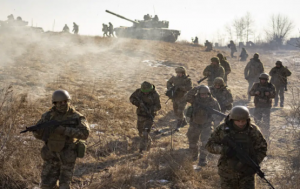
Triumph in Kupiansk could decide future lines of attack for both sides: If Russia succeeds in pushing Ukrainian forces west of the river, it would clear the path for a significant offensive farther south where the administrative borders of Luhansk and Donestk meet. If the Ukrainian defense holds up, it could reveal Russian vulnerabilities and enable a counteroffensive.
The Associated Press spoke about the fighting with generals, commanders and soldiers from three brigades in the Kupiansk area, as well as civilians in the town affected by the grinding battles.
“The enemy is constantly increasing its efforts, but our troops are also increasing their efforts there, making timely replacements and holding the defense,” said Brig. Gen. Dmytro Krasylnykov, commander of the joint group of troops in the Kharkiv region.
Across the towns and villages in the path of the fighting, homes have been razed by constant Russian bombardment, with some residences hit repeatedly. Civilians wait in the cold for food and line up to receive rations of milk and materials to cover shattered windows.
“We don’t have anything to do with this war, so why do we pay the price?” asked Oleksandr Luzhan, whose mother’s house was struck twice.
On the battlefield, Ukrainian soldiers put a rocket launcher in the fighting position, aiming the weapons in line with coordinates sent by their commanders. They wait for the final order.
Seconds turn to minutes. Snow falls silently in thick wet clumps by a shriveled sunflower field.
“Fire!” — a salvo of rockets blasts into the sky toward Russian targets, often armored personnel carriers or tanks. To escape any counterattack, the servicemen of the Ukraine army’s 14th Brigade pack up and leave, trundling away in the Soviet-era BM-21 “Grad.”
Along the northeast front, there are no quick wins, said Vitaly, the operation’s gunner, who gave only his first name in line with Ukrainian military protocols. “It’s war — someone retreats, someone advances. Every day there is a change of position.”
Russia ramped up attacks earlier in February after deploying three major divisions to the area. Fighting is focused northeast of Kupiansk, where Kremlin troops have gone on the offensive with marginal territorial gains. Ukrainian fortifications have so far deterred major advances, Ukrainian senior military officials said.
For Russia, the Kupiansk operation serves two aims: Dislodging Ukrainian forces from settlements along the provincial borders would enable the capture of Luhansk province. Pushing back Ukrainian troops west of the Oskil River and locking them there would create a new defensive line and prevent deployments to the critical Svatove-Kreminna line further south, where a separate Russian offensive is underway to capture the Donestk region by reclaiming abandoned posts in Lyman. Svatove, which was occupied by Moscow last spring, is 60 kilometers (37 miles) southeast of Kupianske.
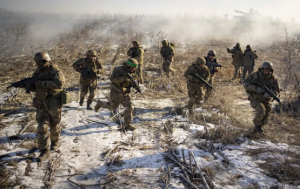
Ukrainian forces are counting on improving coordination between infantry and tank units to deprive Russia of the opportunity to breach Ukrainian lines. Ukrainian forces still control settlements inside Luhansk near the border with Kharkiv.
Artillery and ammunition shortages are a real concern on this front where the landscape is heavily forested, small villages are separated by vast farmland and Ukrainian soldiers come under nine hours of shelling some days. Long-range weapons would contribute to quicker wins in such an environment, Krasylnkov said.
Serhii, an infantry soldier with the 92nd Brigade who also used only his first name, said ammunition shortages were derailing his unit’s ability to advance and occupy enemy positions.
“They can make 40 shots in our direction, and we can fire back twice on target,” he said. “They have quantity, but we are more efficient.”
The months to come will be critical, he predicted. The Russians clearly “want to cut us off from the Oskil River. They want to make it so that we push back our troops … and they can occupy the entire territory along the river from Kupiansk to Kreminna.”
“But we won’t allow this,” he said.
In the debris of a destroyed home where a group of servicemen had been resting was the severed hand of a Ukrainian soldier. Russian reconnaissance drones spotted the soldiers, and on Feb. 17 an S-300 missile split the house in two.
Olena Klymko lives next door. The strike shattered her windows and damaged her roof.
Russian bombardment of Kupiansk, a town with a prewar population of 27,000, has become so frequent that “every time we go to sleep we pray to God we will wake up in the morning,” she said. At times the strikes appear to have clear targets where soldiers pass through. Other times, they are indiscriminate.
The shelling is even more intense in the suburbs of Kupiansk, closer to Russian lines where access to supplies is also limited.
Residents from the border village of Vovchansk drive three hours to a makeshift bridge on the Pechenizhske Reservoir leading to Kharkiv. It is the only way they can retrieve supplies, residents said. They rarely leave their homes, fearful of the intense shelling.
But like many Ukrainians living in similar danger zones along the 1,000-kilometer (620-mile) front line, most are unwilling to leave their hometowns for good.
In the village of Zelena, dozens of older residents waited under a bus shelter amid heavy snows for a food truck to arrive.
“Today is a quiet day, thank god,” said Victoria Bromska, wheeling her food parcel back home.
Luzhan picked up wooden boards and other items supplied by a Swiss aid group called Heks/Eper to seal his mother’s house. About a quarter of those who seek the group’s shelter kits in Kupiansk are coming for a second time. The kits increase indoor temperatures in battered homes,
The home targeted in the Feb. 17 attack had belonged to an older woman whose children evacuated her to Kharkiv. Offering Ukrainian servicemen a place to rest is common, Klymko said, despite the risks.
“How can we say no? she asked. “They are out there fighting for us.”
This story has been corrected to show that Col. Petro Skyba is a battalion commander, not a brigade commander; Dmytro Krasylnykov is commander of the joint group of troops in the Kharkiv region, not head of the Kharkiv military administration; and his last name is Krasylnykov, not Krasylnkov.
____
Newsroom | theworldmail.co.uk
Source/Contribution/Photo Credit by Associated Press


